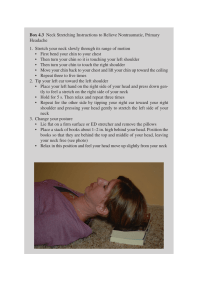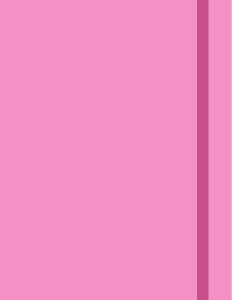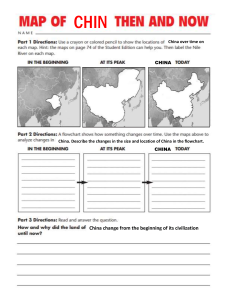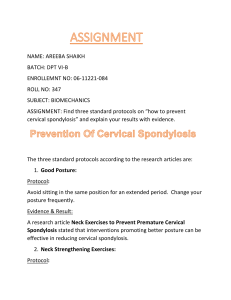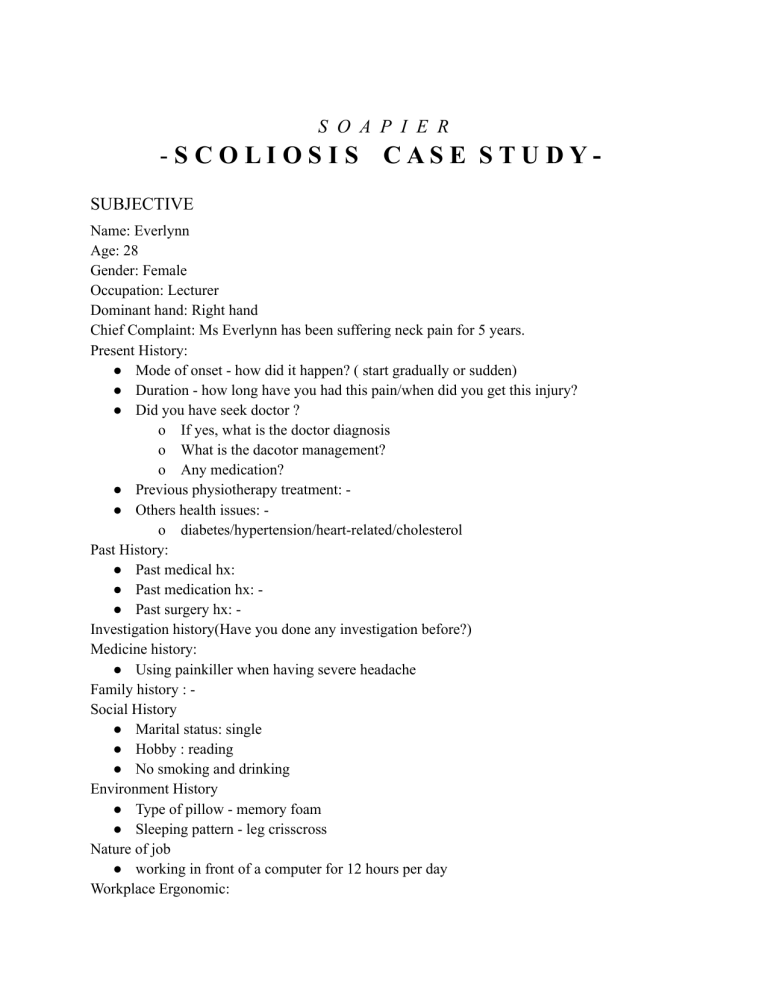
S O A P I E R -SCOLIOSIS CASE STUDYSUBJECTIVE Name: Everlynn Age: 28 Gender: Female Occupation: Lecturer Dominant hand: Right hand Chief Complaint: Ms Everlynn has been suffering neck pain for 5 years. Present History: ● Mode of onset - how did it happen? ( start gradually or sudden) ● Duration - how long have you had this pain/when did you get this injury? ● Did you have seek doctor ? o If yes, what is the doctor diagnosis o What is the dacotor management? o Any medication? ● Previous physiotherapy treatment: ● Others health issues: o diabetes/hypertension/heart-related/cholesterol Past History: ● Past medical hx: ● Past medication hx: ● Past surgery hx: Investigation history(Have you done any investigation before?) Medicine history: ● Using painkiller when having severe headache Family history : Social History ● Marital status: single ● Hobby : reading ● No smoking and drinking Environment History ● Type of pillow - memory foam ● Sleeping pattern - leg crisscross Nature of job ● working in front of a computer for 12 hours per day Workplace Ergonomic: ● ● ● ● Normal plastic chair Elbow level of desk height Monitor height same level with eye Working duration: 12 hours per day, usually take break in between long last for 1 to 2 hours Expected Outcome ● Reduce neck pain Pain Assessment Side & Site: bilateral side of neck, entire cervical region Onset of pain: sudden/gradual Duration: 5 years Type of Pain: dull aching/ sharp/ shooting Nature of Pain: no radiating Aggravating Factor ● Working ● VAS 5/10 Easing Factor ● Take pain killer and rest ● VAS 3/10 Severity: once a week Irritability - High ● After using the pain killer, it takes about 30 minutes to subside 24 hours’ pattern: ● Usually feel the pain after working, and it becomes worsens during night OBJECTIVE I. POSTURE ANALYSIS Head SIDE VIEW FRONT VIEW Forward Head Posture Slightly rotated to the Left Slightly rotated to the Left Cervical spine Normal extension Shoulders Thoracic spine Straight Left side Higher Scapulae BACK VIEW Left side elevated Scapular retracted Left scapular lateral winging Normal Flexion Convex towards Left Lumbar spine Excessive extension (lordosis) Ribcage Rotated to the Right Pelvis Anterior Pelvic Tilting Hip Joints Right side hip hiking (flexed) Femur Right iliac crest and ASIS is higher. Left side is rotated anti-clockwise. Right side higher Normal Straight Knees Neutral Ankle Joints Neutral Feet Convex towards Left Knock knees Knock knees Normal Parellel II. GAIT ANALYSIS ● Reduce arm swing ● Right side pelvic hike III. PALPATION ● Left scapula lateral winging ● No tightness ● No warmthness ● No swelling ● Sternocleidomastoid and cervical para-spinal muscle tenderness grade II ● Posterior neck sore ● Right Rib higher ● Right xiphoid higher IV. DEEP TENDON REFLEX (DTR) Bicep ● Grade 2+ Normal Tricep ● Grade 2+ Normal Brachioradialis ● Grade 2+ Normal Knee ● Grade 2+ Normal Archilles Tendon ● Grade 2+ Normal V. SENSORY EXAMINATION Sensation Result Superficial Sensation Touch Pain Temperature Pressure Deep sensation Kinesthesia Proprioception Vibration Intact Stereognosis Barognosis Tactile Localization 2 point discrimination Graphesthesia Intact Cortical Sensation Intact VI. CHEST EXPANSION ASSESSMENT Axillary level Nipple level Xyphoid level Exhale Inhale Exhale Inhale Exhale Inhale 1st measurement (cm) 70cm 74cm 70cm 72.5cm 57cm 63.5cm 2nd Measurement (cm) 70cm 74.5cm 68cm 72cm 56cm 63cm 3rd measurement (cm) 70cm 74.5cm 67cm 72cm 56cm 63.5cm Average Differences 4.33cm 3.83cm VII. LIMB LENGTH MEASUREMENT Apparent Limb Length: ● Left: 86cm ● Right: 86cm True Limb Length: ● Left: 79cm ● Right: 79cm VIII. GIRTH MEASUREMENT 7cm Arm Girth: ● Left: 20cm ● Right: 20cm ● Forearm Girth ● Left: 8cm ● Right: 8cm Thigh Girth ● Left: 41cm ● Right: 42cm ● Calf Girth ● Left: 33cm ● Right: 32cm IX. RANGE OF MOTION Cervical Active ROM Passive ROM End - Feel Flexion 40° 45° Empty Extension 60° 75° Empty Left Lateral Flexion 50° 60° Firm Right Lateral Flexion 45° 55° Firm Left Rotation 50° 80° Firm Right Rotation 90° 95° Firm Trunk Active ROM Passive ROM Difference Flexion 50cm 52cm 2cm Left – 62cm Left – 42cm 20cm Right – 60cm Right – 25cm 35cm Left – 105cm Left – 102cm Firm Right – 106.5cm Right –105.5cm Firm Lateral Flexion Rotation X. MUSCLE STRENGTH ASSESSMENT (MMT) Muscles MMT Grading Neck Flexors 4/5 Neck Extensors 5/5 Neck Rotators 5/5 Neck Side Flexors 5/5 Trunk Flexors 5/5 Trunk Extensors 5/5 Trunk Side Flexors 5/5 Trunk Rotators 4/5 XI. BALANCE ASSESSMENT Static balance Balance test Four stage balance test: 1. Stand with both feet side by side – 10s 2. Semi tandem stance – 10s 3. Tandem stance – 10s 4. Stand with one foot – 10s Result Excellent Dynamic balance Four step square test: 7s Excellent XII. SPECIAL TEST Adam’s Forward Bending Test Finding: ● Visible left thoracic hump with 15° higher than right side. ● Visible left side thoracic curve Interpretation ● Positive (10 degrees is the cut-off point for scoliosis ) ANALYSIS Physiotherapist’s Analysis ● Reduce range of motion of neck flexion, left rotations are due to forward head posture and compensation to left curvature on the thoracic spine. ● Reduce range of motion of trunk left rotations is due to weakness of left thoracic region paraspinal muscle and tightness of right. ● Reduce muscle power of neck flexor and trunk rotators due to left curvature of scoliosis Short-Term Goals 1. Reduce sternocleidomastoid (SCM) and cervical para-spinal muscle from tenderness grade II to grade 0 within 2/52. 2. Improve the AROM of neck flexion from 40° to 45° within 3/52. 3. Improve the AROM of neck left rotation from 50° to 60° within 3/52. 4. Improve the ROM of trunk left rotation from 20cm to 35cm within 3/52. 5. Strengthen neck flexors from MMT 4/5 to MMT 5/5within 3/52. 6. Strengthen trunk rotators from MMT 4/5 to MMT 5/5within 3/52. Long-Term Goals 1. Correct the gait pattern within 2/12. 2. Correct the posture within 3/12. 3. Reduce the scoliosis curve from 15° to 10° within 4/12. PLANS Pain Relief Hot Pack ● Rationale: Hot packs improve blood flow and promote muscle relaxation as well as reduce the pain through sedation effect by acting on A-delta and C fibres and muscle spindles. And this method can specify the entire cervical region Stretching Exercises Suboccipital Stretch ● Rationale: This stretch will help to loosen the tight muscles at the base of skull, the suboccipital. SCM stretches ● Rationale: based on the ROM examination, the neck rotation is reduced. The function of SCM is the rotation of neck towards opposite side or rotate the head obliquely. A tight SCM muscle not only reduce the neck rotation ROM, it also can contribute to neck pain, and is one of the most common muscles involved in forward head posture. Loosening the SCM muscle helps in improve neck rotation ROM, reduce neck pain and also correct the forward head posture. Sail Exercises (Schroth Method) ● Rationale: The Sail exercise is a very effective stretching exercise, which helps elongate the thoracic concavity. It combines the elongation of the concave side and expansion of convex side to correct the thoracic curve. Strengthening exercises Chin In Exercises ● Targeted muscle: Mainly the deep cervical flexors. ● Rationale: Chin in is the most effective postural exercise for relieving neck pain and correcting the forward head posture. This exercise helps strengthen the muscles that pull the head back into alignment over the shoulders (upper thoracic extensors) and also stretches the scalene and suboccipital muscles. Chin In with Head Lift ● Rationale: This is the progression of the chin in exercises. Shoulder Shrug with Resistance ● Targeted muscle: Left Upper Trapezius ● Rationale: Hypertonicity tends to pull the head down and back, the cervical spinal processes lateral, and the shoulder girdle medial. Left Middle Trapezius Strengthening ● Targeted muscle: Left Middle Trapezius ● Rationale: Based on the posture analysis, the patient is having left scapular lateral winging. Strengthening the middle trapezius tends to pull the T1-T4 (or C7-T3)spinous process lateral and draws the scapula medially. Superman ● Targeted muscle: Left lower trapezius ● Rationale: Increased tone tends to pull the T4–T12 spinous processes lateral and the shoulder girdle medial and inferior. Left Rhomboids Strengthening ● Targeted muscle: Left Rhomboids ● Rationale: Increased tone tends to pull the T2–T4 spinous processes lateral and inferior and the inferior vertebral border up and toward the midline. Patient Education ● Rationale: Other than the treatment session, home exercise program (HEP) and the precautions to patient is very important. Therapist has to educate them the proper way to do the HEP and also remind them about the dos and donts. INTERVENTION Hot Pack Position: Prone lying Equipment: Towel and hot packs Procedure 1. Fold the towel into 8 layers. Separate the towel into 2 layers at the top, 6 layers at the bottom. Put the hot packs in between. 2. Place the towel over the entire cervical region Duration: 20 minutes Suboccipital Stretch Targeted muscle: Suboccipitals Muscles Position: Seated Procedure: 1. To activate the cervical retraction, tuck the chin in. 2. Look down to the jugular notch. 3. Placing two fingers at the chin to passively retract cervical using one hand. 4. Then, place another hand behind the head and passively force the occipital towards the anterior with another hand Duration: Hold 30 to 60s, 2-3 repetitions, 1-2 times per day SCM stretches Targeted muscle: Left SCM Position: Seated or Stand Procedure 1. Start with the head in a neutral posture. 2. To stretch the left SCM muscle to start, rotate the head towards the right side, then gently tilt your head back, to engage and stretch the SCM muscle fibres. 3. Hold the stretch for 30-60 seconds, then gently rotate your head back towards neutral. Protocol: 30-60s, 2-3 repetitions, 1-2 times per day. Sail Exercises (Schroth Method) Position: Erect standing and leg open shoulder width. Procedure: 1. Patient stands on a half foam roll with two poles 2. Right hand higher than the left. 3. Performs active stabilization. 4. The red circle represents the concavity (weak side according to Schroth). During active stabilization, the patient is consciously expanding the right rib cage with left directional breathing, opening the collapsed right lung. Protocol: Hold 30-60s, 2-3 repetitions, 1-2 times per day. Chin In Exercises Targeted muscle: Deep Cervical Flexors Position: Supine lying ( against gravity) Procedure 1. Start with a neutral posture. 2. Place two fingers at the chin to gently push the neck backwards 3. Pull your chin straight backwards, in effect attempting to make a double chin. 4. Therapist palpates the activated muscle while patient doing the exercises Protocol: Hold for3-5s, repeat 10-15, 3 sets per day. Chin In with Head Lift (Progression) Targeted muscle: Deep Cervical Flexors Position: Supine lying ( against gravity) Procedure 1. Start with a neutral posture. 2. Place two fingers at the chin to gently push the neck backwards 3. Pull your chin straight backwards, in effect attempting to make a double chin. 4. Slightly lift the head off the bed and hold. 5. Therapist palpates the activated muscle while patient doing the exercises Protocol: Hold for 3-5s, repeat 10-15, 3 sets per day. Shoulder Shrug with Resistance Targeted muscle: Left Upper Trapezius Position: Prone Lying Procedure 1. Perform the chin in then depress the bilateral shoulder. 2. Therapist places the resistance manually on the left shoulder with one hand. 3. Instructs patient to lift the left shoulder against the resistance and hold. Protocol: Hold for 3-5s, repeat 10-15, 3 sets per day. Left Middle Trapezius Strengthening Targeted muscle: Left Middle Trapezius Position: Prone Lying Procedure 1. Perform the chin in then depress the bilateral shoulder. 2. Exercise to strengthen the middle trapezius muscle using a long lever arm for resistance. Abduct both shoulders to 90 degrees and both elbows straight. 3. Therapist instructs patient to contract the middle trapezius muscle with retracts and adducts her scapulae, lifting her arms toward the ceiling. And hold for 3-5s, with 10-15 repetitions. 4. Instruct patient to remain left hand at the side of body while keeping right hand beside the body. 5. Therapist palpates the activated muscle while the patient doing the exercises Protocol: Hold for 3-5s, repeat 10-15, 3 sets per day. Superman Targeted muscle: Left lower trapezius Position: Prone Lying Procedure 1. Perform the chin in then depress the bilateral shoulder. 2. To activate the lower trapezius, lift both hands over the head like a “Y-shape”. Then lift the shoulder off the plinth. Hold for 3-5s, repeat 10-15. 3. Instruct patient to remain left hand over the head with the elbow straight while keeping right hand beside the body. 4. Lift the shoulder off the plinth and hold. 5. Therapist palpates the activated muscle while patient doing the exercises Protocol: Hold for 3-5s, repeat 10-15, 3 sets per day. Left Rhomboids Strengthening Targeted muscle: Left Rhomboids Position: Prone Lying Procedure 1. Perform the chin in then depress the bilateral shoulder. 2. To activate the rhomboids, bring both hands toward the midline of back. Then, lift both shoulders off the plinth and squeeze the muscles together. Hold for 3-5s, repeat 10-15. 3. Instruct patient to remain left at the back while keeping right hand beside the body. 4. Lift the left shoulder off the plinth and hold. 5. Therapist palpates the activated muscle while patient doing the exercises Protocol: Hold for 3-5s, repeat 10-15, 3 sets per day. EVALUATION Evaluation in post-treatment: ● Visual Analogue Scale: to reassess the neck pain scale after the treatment ● Range of Motion Assessment: to reassess the neck and trunk ROM after the treatment Response from patient ● Evaluate the cooperative and attention level of patient can help in the further improvement. If notice the patient is not able to focus on the treatment or easily gets fatigued and needs to take a longer duration to rest. Therapist can do some adjustments to the intervention to make the treatment become more effective. REVIEW Component that will check in next appointment ● VAS ● ROM ● MMT ● Scoliometer To come again: Next appointment date and time REFERENCE 1. Journal of Orthopaedic & Sports Physical Therapy Published Online:October 31, 2013Volume43Issue11Pages841-847 https://www.jospt.org/doi/10.2519/jospt.2013.4659 2. Berdishevsky, H., Lebel, V.A., Bettany-Saltikov, J. et al. Physiotherapy scoliosis-specific exercises – a comprehensive review of seven major schools. Scoliosis 11, 20 (2016). https://doi.org/10.1186/s13013-016-0076-9
